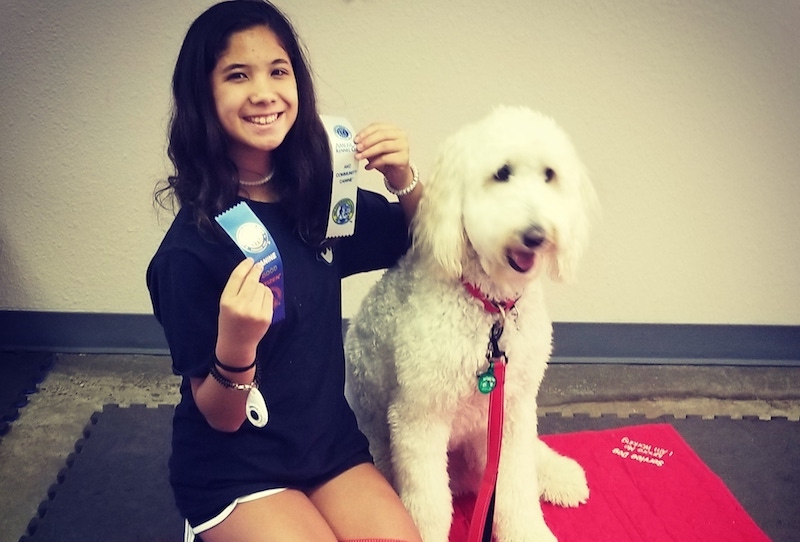My life as a seizure alert dog

I’m Alo, a seizure alert dog. The story of how I got my name is pretty funny. Liyana, my best human friend, has epilepsy. One day, she was telling her nurses at Boston Children’s Hospital that she was getting a service dog. She had to pick a name and had chosen Alice. But she wasn’t sure what to call me if I was a boy, which I am. One of the nurses joked, “Aloe Vera,” because she was putting that on Liyana’s arm. And Liyana was like, “That’s it!” So at 1 year, 8 months old, I’m the only goldendoodle on the planet named Alo Vera (but you can call me Alo for short).
It makes perfect sense that no one would have my name because no dog has a job more important than mine. In addition to being her best dog friend and a rabid (not literally) Patriots fan, I’m Liyana Hunter’s seizure alert dog.

My very important job
Since I was a puppy, no matter what time of day or night, I’ve always been on the job. I can sense when Liyana will have a seizure one or two minutes before it happens. Even if I’m asleep, my spidey-sense wakes me up and says, “She’s going to have a seizure!”
My bark is the best tool I have to call for help. I make the most obnoxious sound and boy does it carry—best seizure alarm ever. Liyana’s parents come right away and use the rescue medication I carry with me to help her. When we’re at school, barking can be distracting for the other kids. Instead, I press a button on the floor. It alerts Liyana’s teacher and school nurse through special watches they wear.

I’m always on duty. I can’t ever be distracted, not even by annoying birds or other dogs — even the little ones who won’t leave you alone until you say hello. I tell them, “Hey, check out my shirt. I’m this awesome 13-year-old’s service dog.”
This girl’s going places
You might think I’m really smart, but what makes me extraordinary isn’t about me at all. It’s that I get to devote my life to the smartest, most generous, and most talented girl in the world. She’s barely a teenager and Liyana is already an award-winning competitive dancer. You name the dance — tap, jazz, ballroom dancing, hip hop — and Liyana kills it. (Check out the video below if you don’t believe me.) I’m always backstage, cheering her on.
When she’s not on the dance floor, Liyana spends all her time helping other people. What started as a toy drive for epilepsy patients at Boston Children’s has grown into her own foundation. Now she donates toys to kids across the country.
Liyana’s got style, too. She thought the epilepsy monitoring unit rooms at Boston Children’s were way too boring. So , she and Andrea Lerude, a child life specialist, decided to decorate each one in a different theme. Now they’re working with students from MassArt to paint the windows. All this and she’s only 13!

The trip of a lifetime
I could talk all day about my best friend, but I have to go. I’m training really hard right now for a very important trip. Liyana and I are traveling soon to Boston for her next surgery. I’ve been practicing at our local airport in Dallas, learning how to go through the security line and board the plane. I’ve almost got it down.
I’m excited to meet her doctors, nurses, and Andrea. Liyana even said there’s a special new place at the hospital for service dogs. I finally get to be there for Liyana when she’s in the hospital. I won’t leave her side and I’ll do everything I can to keep her safe and happy.
Get ready Boston. Alo and Liyana are on their way!
Learn more about the Epilepsy Center.
Related Posts :
-

“Princess June” reigns supreme over Rasmussen syndrome
What do you call a “girly” 5-year-old who adores dolls and frilly nightgowns? If you’re one of June Pelletier’...
-

Status epilepticus: What’s changed, what to know, and a global perspective
Status epilepticus, or a prolonged seizure lasting more than five minutes, is a rare complication of epilepsy and a medical ...
-

For Fiadh: Pushing the envelope to treat drug-resistant epilepsy
Fiadh is a bubbly and empathetic 4-year-old. And if you ask her parents, Elaine and Dario, she’s also mischievous ...
-

Finding epilepsy hotspots before surgery: A faster, non-invasive approach
Neurosurgery for patients with drug-resistant epilepsy requires locating the precise brain areas that are generating the seizures. Typically, patients undergo 7 ...





